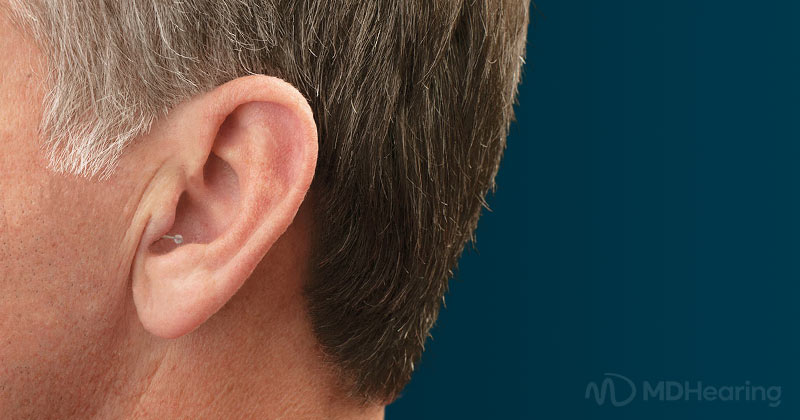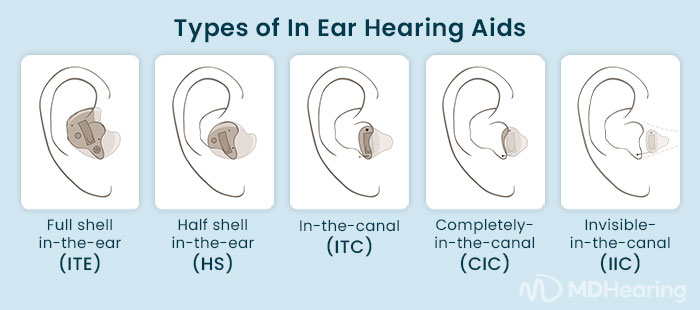For people with hearing loss, numerous options are available on the market today. While all hearing aids are designed to help you hear better, in ear hearing aids may be more beneficial for you. Not only do they provide a comfortable fit with a discreet look, but they also offer advantages you won’t get with other styles. Regardless, it’s crucial to explore your options and work with a hearing professional to find the perfect hearing aid for you.
What Are In Ear Hearing Aids?
All hearing aids consist of three main parts: a microphone to pick up sound, an amplifier to increase the sound, and a receiver to deliver the sound to your ear. While the types of hearing aids vary widely based on their technology and features, the main difference lies in how they fit—in your ear or on your ear.
The three most common types of hearing aids include the following:
-
Behind-the-ear (BTE) hearing aid
-
Receiver-in-the-canal (RIC) hearing aid
-
In-the-ear (ITE) hearing aid
Both BTEs and RICs rest behind the ear, and the sound travels to the ear canal through either a thin, clear tubing or a receiver wire. Whereas ITEs fit entirely in the bowl of your ear or ear canal without any wires, tubing, or anything resting behind your ear.
Types of In Ear Hearing Aids
In ear hearing aids are often custom made to fit your particular ear, but there are many OTC (over-the-counter) options that are one-size-fits-all as well. They’re made of hard plastic, and they fit either in the concha (the bowl-shaped part of the outer ear) or inside the ear canal. They typically come in five styles:
-
Full shell in-the-ear (ITE) hearing aid — fits in the entire concha
-
Half shell in-the-ear (HS) hearing aid — fits in the lower half of the concha
-
In-the-canal (ITC) hearing aid — fits in the lower part of the concha
-
Completely-in-the-canal (CIC) hearing aid — fits nearly invisibly inside the ear canal
-
Invisible-in-the-canal (IIC) hearing aid — fits invisibly deep inside the ear canal
Most in ear hearing aids can assist mild to moderate hearing loss. Generally, the smaller the device is, the less powerful it can be. However, some larger models can be suitable for severe hearing loss.
MDHearing currently offers two styles of in ear hearing aids: the NEO (an ITC hearing aid) and the NEO XS (a CIC hearing aid). Both have a small, inconspicuous design but as a CIC model, the NEO XS sits further within the ear canal than the NEO. The NEO XS is also roughly half the size of the NEO, making it the smallest hearing aid that MDHearing has to offer. In fact, the NEO XS is the smallest CIC hearing aid that’s available over-the-counter (OTC) for less than $1,000.
Pros and Cons of In Ear Hearing Aids
There are many advantages and disadvantages to using in ear hearing aids over other styles, but these vary depending on the type of in ear hearing aid.
In-the-ear (ITE) hearing aid
Advantages:
-
Typically custom fitted
-
Large enough for more advanced features, such as directional microphones
-
Larger battery with longer battery life
-
Easy to insert and remove
Disadvantages:
-
Typically only available in a hearing clinic
-
Least discreet hearing aid style
-
Most occlusion
-
May leave a "plugged up" feel
-
Not always comfortable
In-the-canal (ITC) hearing aid
Advantages:
-
Can be custom fitted in a clinic or available as a one-size-fits-most option
-
Easier to use controls than CIC and IIC
-
Larger battery with longer battery life
Disadvantages:
-
Doesn't sit as deep in the canal as a CIC or IIC
-
More noticeable than CIC and IIC
-
May leave a "plugged up" feel
-
Not always comfortable
-
Susceptible to wax build-up
Completely-in-the-canal (CIC) hearing aid
Advantages:
-
Can be custom fitted in a clinic or available as a one-size-fits-most option
-
One of the most discreet hearing aids
-
Sits deep in the canal
-
Comfortable
-
Less wind noise
Disadvantages:
-
Limited user controls, if any
-
More difficult to handle for those with dexterity issues
-
Vulnerable to wax build-up
-
Can require more repairs
-
Smaller battery with shorter battery life
Invisible-in-the-canal (IIC) hearing aid
Advantages:
- Can be custom fitted in a clinic or available as a one-size-fits-most option
-
Smallest, most discreet hearing aid
-
Sits very deep in the ear canal
-
Least amount of wind noise
Disadvantages:
-
Limited sound controls, if any
-
Controls are harder to see and feel
-
Difficult to handle for those with dexterity issues
-
Most vulnerable to wax build-up
-
Requires more repairs
-
Smaller battery with shorter battery life
Main Features of In Ear Hearing Aids
In ear hearing aids come with an array of features. These features help you hear better while offering convenience in a discreet design. Although small in size, many in ear hearing aids can handle advanced features.
Custom-Made Fit
In ear hearing aids are often tailored to the exact shape of your ear. They tend to be more comfortable if you have an uncommon ear shape or size. In addition, they can be made to match your skin tone, so the flesh colors blend in better and aren’t as noticeable.
Simple Controls
The small design of in ear hearing aids means they have simpler controls, if they have any at all. In ear styles are usually limited to volume or program control, although some have Bluetooth compatibility for changing volume or programs. Many of the smaller CIC and IIC ones do not have Bluetooth due to their small size.
Tiny Battery
In ear hearing aids accommodate very small batteries, allowing the device to be small enough to fit deep in the ear canal. Some models use rechargeable batteries, which helps cut down on costs and environmental waste.
Feedback Cancellation
Most of the latest models of in ear hearing aids have tiny computer chips to minimize feedback. That way, you can wear a hat or hug a loved one without experiencing that annoying whistle.
Noise Reduction
In ear hearing aids may also feature noise reduction. This technology can identify and filter out background noise, so you can more clearly hear people talking.
You Might Benefit from Wearing Hearing Aids
With so many types of hearing aids to choose from, it can be daunting to know which one is best for you. In ear hearing aids offer many advantages, however, you may find that one of the other types of hearing aids works better for your lifestyle. It’s essential to weigh the pros and cons of each—and seek guidance from a hearing specialist to evaluate all of your options.
Have you been noticing that you or a loved one is having trouble hearing lately? Take our free online hearing test and get immediate results!
At MDHearing, we understand the challenge of communicating with friends and family or enjoying your favorite pastimes when you have hearing loss. That's why we’ve cut out the middleman to bring more affordable hearing aids directly to you.
We offer high-quality, FDA-registered OTC hearing aids at a fraction of the cost you’d get through a doctor or clinic. Plus, we back up all of our hearing aids with a 45-day risk-free trial and 100% money-back guarantee, so you can try them worry-free. Our licensed audiologists and hearing specialists are ready to help get comfortable with your new hearing aids and hear your best.
Start by taking our quick and easy online hearing test now.
TAKE ONLINE HEARING TEST

